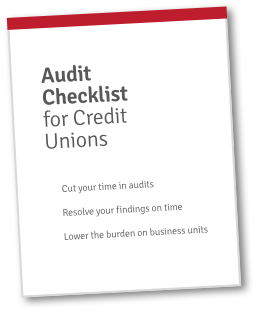“I never knew it could be like this!” “It’s like I’m seeing for the first time,” and of course, “I’m never going back to the way it was before.”
Have you heard someone describe what it’s like to put on eyeglasses for the first time? Thousands of people walk around every day through a blurry, formless world. It’s not necessarily difficult—although for some it is—but there’s a distinct lack of clarity. Many with bad vision don’t even know what they’re missing.
But This Is About Credit Unions…
Trying to navigate the credit union audit process is a lot like having bad eyesight: you can get around okay, but things get muddled, murky, and mixed up. Most importantly, it’s easy to miss details because you can’t see the whole picture well.Point West Credit Union noticed that their NCUA audit process was manageable, but cumbersome. In an effort to streamline their audit process, they tried several common strategies. They involved key experts. They hired an internal auditor. Finally, they turned to Redboard.
Dealing with the NCUA Audit Environment
The credit union examination cycle is frequent, time-consuming, and stressful. It’s not that audits can’t be done (or done right)—they can. The issue is that audits rob credit unions of valuable time. Worse, if the NCUA doesn’t like what it sees, the audit can stretch on seemingly forever.Like most credit unions, Point West wasn’t having trouble with their audits, per se. The constant, long-lasting NCUA audit cycle ensures all credit union management can navigate an exam. Consequently, Point West had a history of clean audits with no adverse findings.
“The audit program of Point West, like most organizations, is fairly manual—or at least, it was,” explains Stephen Pagenstecher, VP of Member Experience at Point West Credit Union. “[There were] lots of emails back and forth, lost items, miscommunications. You know, the program itself was sound, but how it came together and how it aggregated the data, reported it out, was very manual and very cumbersome.”
On its surface, everything at Point West looked fine. They weren’t dealing with any audit horror stories aside from the occasional answer to follow up on. Aside from that, no regulatory action, no DORs, no errant findings, and no missed due dates. Like most credit unions, they were making it work with email and spreadsheets.
Nothing to See Here: The Meat of the Issue
At just over 100 million dollars, Point West Credit Union isn’t large. Yet, their audit program had grown considerably, to the point where they hired an internal auditor to help.Despite bringing on an experienced internal auditor, Point West still felt that the process was poorly optimized. There was a lot of manual-level communication, document preparation, and collection.
Point West’s audit team felt that their audit process was needlessly convoluted. In each audit, as they aggregated documents, they noticed they were spending a considerable amount of time coordinating with one another, making sure there were no duplicate files, and addressing version control issues.
Point West’s audit process worked, but Pagenstecher and his team felt that it was difficult to see all the details of their audit. They needed something to help them focus on the audit so they wouldn’t get lost in the murky audit process.
Point West’s Issues with the Audit Process Are Common
“The credit union regulatory space, in general, is difficult—especially for credit unions of a certain size,” Pagenstecher notes. “Staying on top of all of the compliance—and how it evolves over time—is really difficult.”Pagenstecher and Point West were dealing with the usual complications associated with smaller credit unions. They have fewer resources to work with, including limitations with the big three:
- Time
- Personnel
- Money
Accordingly, Point West’s audit team was small and overloaded. Their team comprised heads of different business departments, their CEO, and their auditor. For all but the auditor, their time spent actively removed them from higher-level and member-facing tasks.
Big Credit Unions Need Love Too
Audit issues like the above don’t disappear for larger credit unions, though. Larger credit unions sometimes deal with different regulations, and their audit programs are much larger.The most notable difference between larger and smaller credit unions is that larger credit unions have more to keep track of. Partially because, and partially in spite of their larger audit teams, they face an increased risk of miscommunications, missing items, double-answering, losing version control, and allowing things to slip through the cracks.
Additionally, larger credit unions tend to hire internal audit staff. While they are certainly help, it puts a lot of pressure on them to succeed. They have to report any negative findings to the team and the board, which makes for a stressful work environment.
Point West Looked for a Better Credit Union Compliance Solution
Point West Credit Union needed more clarity through the muddy waters of the NCUA audit landscape. They spent so much time focusing on their audit process that their audits were taking far longer than they needed to.Pagenstecher and his team started looking for a way to increase their efficiency with audits. They knew they needed to optimize their audit environment in two areas: efficiency and accountability.
1. Efficiency
Point West’s first need was to find a way to increase their efficiency and save time on the audit process. They needed to know:- What had been done
- What was being done
- What was left to be done
Having a clear view of the above would help them work through their audits more efficiently because they would be better able to prioritize.
They also noted that shortcomings regarding their view of the audit process was slowing them down. Not knowing what had and hadn’t been addressed meant increased risk from:
- Missing items
- Miscommunications
- Version control issues
- Repeat findings
- More time spent managing the process
They felt that the audit process could be streamlined so that the above issues would rarely—if ever—pop up. They wanted to spend more time addressing findings and answering questions, and to spend less time coordinating the manner of their efforts.
2. Accountability
Point West also wanted to increase accountability in their audits. Audit teams are built of knowledgeable experts in their field. However, coordinating their discrete areas of knowledge isn’t always easy, nor is communication always perfect.Pagenstecher and Point West Credit Union wanted a better way to keep track of all the moving parts in an NCUA audit. They wanted a clearer, more defined vision of people’s responsibilities. Their goal was to keep track of:
- Who is working on an item
- Which items are in progress
- When each item is due
Additionally, Point West wanted key members of the team to receive updates on progress. Anything else, such as improved or more secure communication, was icing on the cake.

FREE: Audit Checklist for Credit Unions
4 key principles and 9 questions to jumpstart your audit planning. From leading credit unions.The Wrong Credit Union Compliance Software
Unfortunately for Pagenstecher’s team, their audit tools weren’t doing them any favors. They had been working with Microsoft’s Excel and Outlook to manage their audits.Although Excel and Outlook are fantastic programs when they’re used for what they’re designed to do, they fall short for NCUA compliance purposes.
In Part 2 of this series, Point West found that Excel and Outlook were actively complicating their audit process. You can read Part 2 of Point West’s audit journey.
In Part 3 of this series, Point West optimized their audit process by using Redboard’s simple software.
You can download the entire Point West case study here.
You can also read some of our related blog posts here:
The Hidden Risks in Credit Union Regulatory Examinations — and How to Avoid Them
5 Strategies to Avoid Risk During Your Credit Union’s Next Regulatory Examination






